E.ON SE: Introducing low voltage observability and congestion management
Westnetz is the largest electricity DSO in Germany by geographical area with approx.. 7 million customers, maximum load and a number of other parameters. The service area of the 110 kV grid covers an area that is about the size of the Netherlands. With approx. 1,5 million customers Avacon also is one of the largest DSOs in Germany being responsible for another large chunk of the 110 kV grid in Germany and for an area that is characterized by heavy investments in wind.
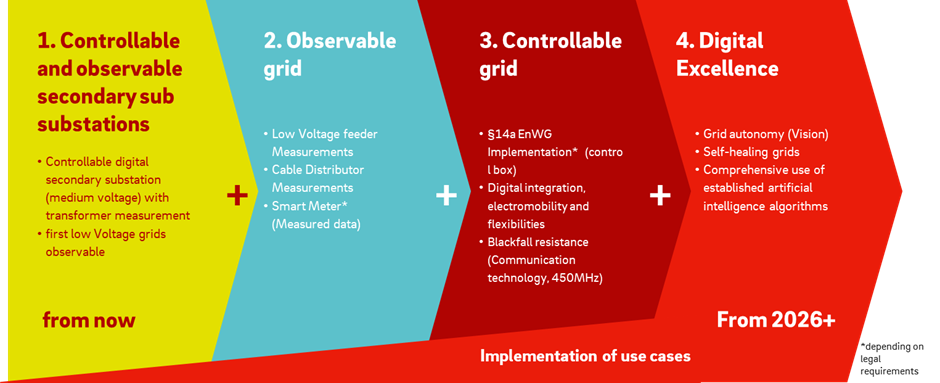
Overview:
Digitalised distribution grids in Germany are an essential part of a green transition as yet another significant increase of intermittent renewable resources is expected in upcoming years. According to German “Osterpaket”, which is a climate protection program by the German Government, a total of around ten million new plants must be connected to our grids in Germany alone until 2030. These large generation capacities will almost entirely be connected to the distribution grid (> 70%), with a significant amount being connected to the E.ON grid area. In addition, Westnetz and Avacon will integrate millions of electric vehicles and heat pumps into their grids over the next years as Germany moves towards a climate-neutral future.
To integrate such large numbers of new generation and loads, grid expansion and digitization at distribution level is key. E.ON therefore has defined a roadmap to expand and digitize its distribution grids.
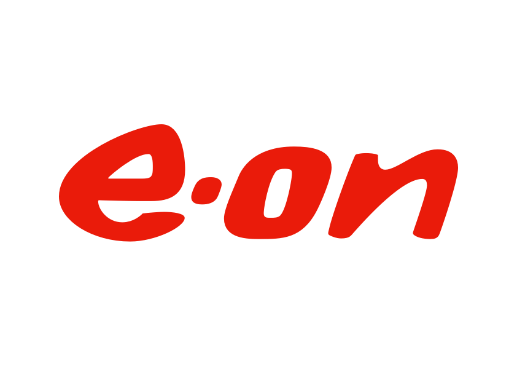
To speed up development and scalability of solutions necessary to realize the roadmap shown, the smart grid project “E.ON Lab” has been set up in two regions in Germany. These regions are used as a platform at scale to learn and validate benefits coming along with digitization of distribution grids and to facilitate scaling of validated solutions across all of E.ON.
At E.ON Lab we accelerate the rollout of smart assets at scale (pre-scaling), establish observability in low voltage networks, develop digital smart solutions, validate the added value of smartification, and contribute with lessons learnt for digitization and scaling in the Group.
In this respect, both Westnetz and Avacon are installing a high share of digital secondary substations, which can observe the LV and MV grid, which can be controlled remotely, also retrofitting of older stations and the installation of smart meters are an integral part of the program.
Based on grid related data, which we obtain from our smart assets, different digital solutions are developed and rolled out in two regions. The main purpose is to enable grid observability through state estimation and identify grid congestions as well as resolve those automatically based on available flexibilities and automated decisions in the near future. Envelio technology is used at the core of E.ON DSO solution to enable grid observability and congestion management.
All components and solutions are based on common standards across all E.ON-DSOs to facilitate and speed up scalability across E.ON.
To gather all grid related data points a central data platform has been introduced. Existing processes are being adapted to incorporate new data points, such as live measurements, for the purpose of grid operations and in support of grid planning – new information is fed back into existing processes (eg, for managing outages) to improve efficiency and effectiveness.
Objectives:
- Minimizing risk: Validation of functionality and scalability of new technologies and solutions helps to minimize risk before scaling across E.ON.
- Platform for regulatory questions: We provide impulses in the context of regulation through agile solution development and testing the impact of regulatory policy on grids under real operational conditions.
- Turning size into digital strength for the energy transition: We digitize our distribution networks on a large scale in a lighthouse project and demonstrate feasibility and benefits for the energy transition in real life.
Context, Challenges, and Framework
Industry Landscape:
The necessity for a fast digitization of distribution grids is driven by ambitious political goals to transition energy generation to mainly renewables (80% until 2030). Therefore, a significant increase in renewable resources, in particular PV-installations (4x compared to 2021), electric vehicles (12x), heat pumps (8x) etc. is expected in upcoming years in the area of Westnetz GmbH in Germany, alone. However, distribution grids in Germany are not yet prepared to integrate that volume of renewable generation and loads. At the same time there is currently very limited transparency at low voltage level available as only a few smart meters and other sensors are installed.
According to current legislation there is a need for DSOs across Germany to control flexible loads (e.g. EVs, heat pumps etc.) to avoid grid congestions (§14a EnWG-Germany). DSOs also need to use §14a EnWG as they are no longer supposed to deny connections in LV. This creates an urgent need for grid observability at low-/medium voltage level in Germany.
Roadmap:
The use-case "LV-Observability and Congestion Management" described here refers to "operation" and addresses "grid operational efficiency" as well as "Flexibility Management". All components installed and operated based on E.ON standards and therefore are at minimum "advanced" according to the Accenture roadmap in the report.
Specific Challenges Addressed:
- Currently, there is no or very limited observability at low voltage level across Germany
- Urgent need to obtain observability as a prerequisite to control flexibilities to avoid grid congestions.
- Speed up scalability of innovative solutions through testing at large scale at E.ON Lab
Solution Overview
The E.ON Lab platform as illustrated below encompasses different smart assets. To transmit data, which is gathered by those assets, a mix of different communication technologies is used. “450 MHz” communication technology is used as a backbone to ensure operation in case of losing connection or communication outage.
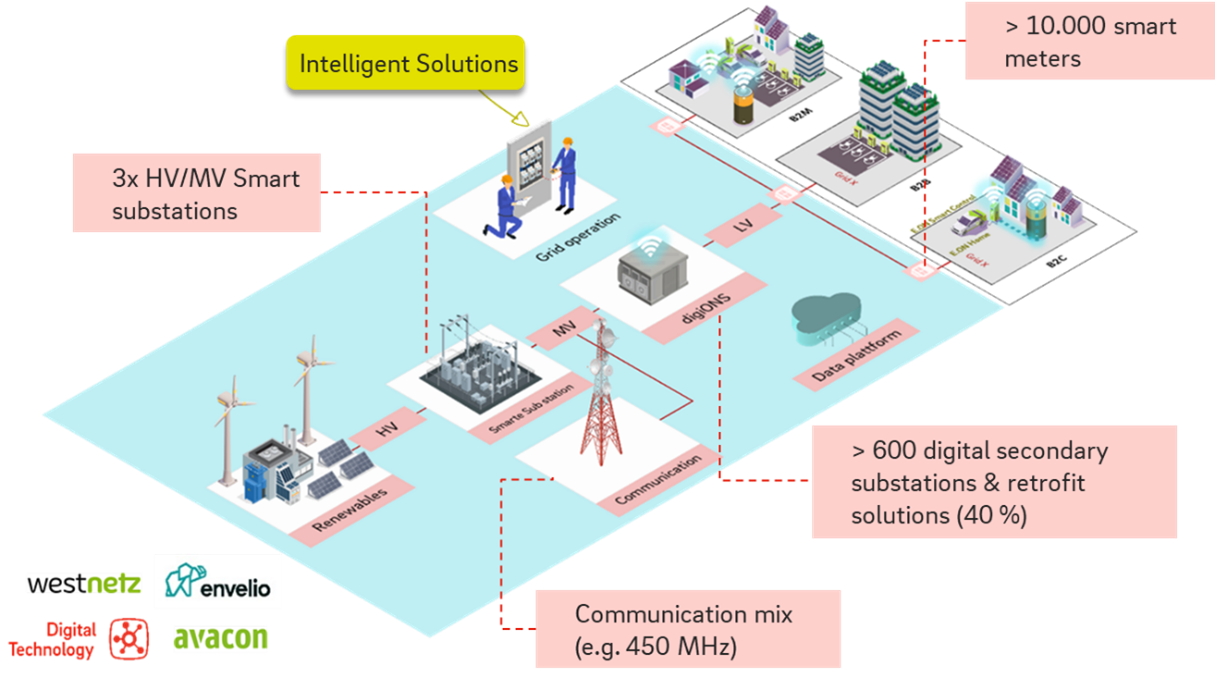
Solution Description:
A standardized approach is applied across E.ON to facilitate scalability and is described in an established Digital Big Picture:
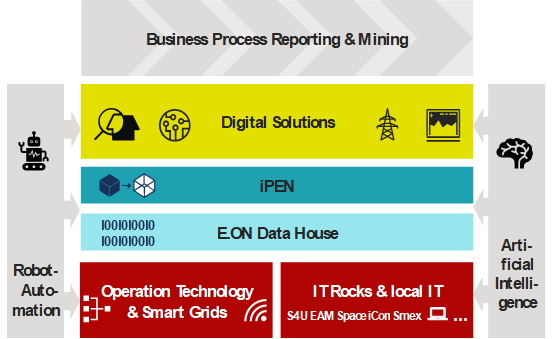
Our main IT Projects, also called “IT Rocks” & local IT and Operation Technology & Smart Grids are the foundation of the Big Picture, represented in the so-called red layer. On the IT side, the business operations rely on the “IT Rocks”, defined for standardization and to supplement local IT systems. The Operating Technology (OT) side includes all the operation hardware, software and communication required to safely control our grid. This also includes smartification activities in our medium and low voltage grids.
One step further up, the E.ON Data House layer makes all data from the underlying systems technically available. In the iPEN layer, the relevant data from the E.ON Data House is transformed into a uniform data model. This model serves as a digital twin for our electricity and gas grids and is the basis for the digital solutions.
Above iPEN, the Digital Solutions in the yellow layer use the data from iPEN. A common solution portfolio is jointly developed and can be scaled by business units easily. To address relevant business needs when developing common solutions, four focus topics are defined (represented by the symbols): Municipalities & Concessions, Digital Planning & Construction, Digital Inspection & Maintenance and Network Monitoring & Operation.
To master the energy transition, we need to standardize, digitize and automize our business processes. Therefore, all digital activities must support our core business processes. That’s why, On top of the technical layers, we enhance our Digital Big Picture with the layer “Business Process Reporting & Mining”. It enables us to prioritize and steer our activities by having an end-to-end view of our processes with clear KPIs.
On the left and right of the picture, “Robotic Automation” and “Artificial Intelligence” are added to booster digitization and automation across all layers.
Especially our intelligent Platform Energy Networks (iPEN) supports to transform the distribution networks into intelligent platforms that control complex energy and data flows. iPEN aims with new options for dealing with energy and support the energy transition and climate protection efforts.
Key features of our scalable smart grid:
- Digital Solutions: E.ON utilizes digital solutions, including artificial intelligence (AI), smart metering, smart secondary substations, and digital twin technology, to enhance network operations and optimize processes. These solutions enable the collection and analysis of data from smart networks and standardized systems, facilitating the scaling of smart solutions. All digital solutions are based on E.ON standards, e.g. use the same data platform (iPEN), standardized interfaces etc.
- Standardization and Smartification: We implement smart assets (digital secondary substations etc.) and solutions based on E.ON standards. In this respect, iPEN forms a key basis for the standardisation of processes and the integration of smart technologies to improve customer service, metering, and finance processes. It involves the integration of external data sources such as weather data, videos, and images to enhance control center systems.
- Envelio Integration: E.ON has integrated the envelio GmbH solution into its ONE platform for Energy Networks. This integration enables automation of processes for the integration of new distributed energy resources and consumers.
- Grid Connection and Planning: iPEN enables automation of grid connection processes and evaluation of the effects of grid expansion measures and changes in supply tasks. These advancements lead to faster processing of network planning processes and improved efficiency.
- Operation Management: iPEN and corresponding digital solutions also focuses on monitoring of devices for live grid transparency and optimization of operation management. This ensures efficient operation and management of the grid.
Digital Solutions at E.ON Lab
We develop our digital solutions based on existing standards and solutions, e.g. envelio grid monitoring, also considering business needs and user feedback.

1) Grid Monitoring:
At E.ON envelio is a solution provider for Grid Monitoring, which is mainly used for grid planning purposes. The main features of the Grid Monitoring are:
- Visualization of historical and online data
- Visualization of grid topology
- State Estimation
- Detecting incidents in the grid (considering historical and online data)
2) Field Assistant (Mobile):
This application serves dispatchers and technicians in their daily business providing additional features relevant during grid operation visualizing historical and online data on a tablet. Relevant features include:
- Optimized resupply strategies after grid failure
- Increase of data quality – Technicians can correct false data (in case there is a deviation between the field installations and what is shown on their app)
- More features are expected in near future
3) Control of flexibilities according to § 14a EnWG (German law) to avoid grid congestions:
Together with the E.ON project “eNet”, we at E.ON Lab implement the legal requirements for curative control of flexibilities in low voltage in accordance with §14a EnWG. For this purpose Grid Monitoring and other tools are used to observe grids and detect grid congestions. In case of grid congestion the power consumption of flexibilities (room cooling, heat pumps, battery storage and electric vehicles) can be reduced up to 4,2 kW. The reason being is that DSOs in Germany cannot deny grid connection of flexible loads.
Implementation Details
Stakeholders:
- Regulators: Regulatory bodies oversee the energy sector and ensure compliance with regulations and standards. They play a key role in shaping the policies and frameworks for the grid, its operation, components and thus for iPEN.
- Technology providers develop and provide the technology solutions for intelligent platform energy networks. They design and implement the software and hardware components required for efficient grid management. One major technology provider is “envelio”.
- Grid operators at E.ON: Grid operators are responsible for managing and maintaining the electricity grid. They play a major role in integrating standards, technologies and solutions, such as iPEN into the existing infrastructure.
Challenges Encountered:
Our smart grid platform in two German regions helps us to identify upcoming challenges with digitization of regions at scale identify and validate requirements for future solutions. Throughout our journey we’ve encountered different challenges, which we have been learning from. Challenges and lessons can be categorized as follows:
- Digitization of distribution grids requires standardization and is a “marathon” rather than a sprint:
- Digitization requires a high grade of standards throughout the entire energy sector, ranging from interfaces to different IT-systems up to standards defining the physical form or structure of buildings for digital secondary substations. Not all necessary standards and interfaces have been defined yet, e.g. in Germany there currently is no technical standard defined on the required no. of sensors to obtain observability at low voltage level. Therefore, we’re currently conducting different studies on this topic.
- During the pandemic the supply chains throughout the world was affected severely. To speed up again with installation a high number of assets, such as digital secondary substations and smart meters to digitize grids requires “endurance”.
- Processing mass data: smart grids generate vast amounts of data from smart meters, digital secondary substations, IoT devices and other sensors. Managing, analyzing, and extracting actionable insights from this data can be complex and challenging. It requires robust data management systems, advanced analytics capabilities, and skilled personnel. Within E.ON Lab we learn and apply different data analytics to identify critical spots in the grids for instance and also identify patterns, which can be transferred onto other regions or DSOs to enhance grid planning processes etc.
- Scalability and complexity: Ensuring scalability of observability and control of flexibilities across E.ON requires a massive investment as well as specific expertise in various fields. Lots of coordination is necessary within very complex environments incorporating different stakeholders such as DSOs, customers, metering point operator etc., considering lots of different new assets (heat pumps, cooling systems, electric vehicles, photovoltaic etc.) to be connected to distribution grids.
- At E.ON we test scalability under real grid conditions in two regions in Germany: Conducting thorough scalability testing is essential to ensure that the system can handle increased loads and maintain performance. Besides, simulating realistic scenarios and stress testing the system can help identify any limitations or areas that need improvement. Also, regularly monitoring the performance of a system and identifying potential bottlenecks or areas for improvement is essential. This allows for proactive optimization and ensures that the system can handle increased workloads without compromising performance. E.ON Lab is designed to proactively learn, iterate and optimize systems.
- Automation of processes is key to scaling, such as managing configurations for thousands of different assets.
- Data Quality: Automation of processes in distribution networks, such as control of flexibilities to avoid grid congestions, require a sufficient data quality (to properly detect congestions). To increase quality we first identified relevant issues at E.ON Lab, their patterns, ranked them and derived measures. As an example, we’ve identified that in some cases measured data was not plausible. Its root cause was identified as wrong parameter settings in sensors.
Functionality and Users:
At E.ON Lab, there are various user roles that contribute to the development and implementation of our vision of a smart grid. In this respect, skills ranging from Data Scientists, software developers, engineers, technicians, project managers, system operators to compliance experts are required (this is not an exhaustive list).
Key Performance Indicators (KPIs):
We’re currently validating the benefits coming along with digitization considering different KPIs. As the validation is still ongoing there is no result yet available.
- Efficiency and Reliability Improvements: Metrics related to the improvement of processes, efficiency, and reliability across the DSO’s activities:
- enhanced reliability, greater safety, increased efficiency, reduction of downtime
- increased SAIFI and SAIDI
- time savings, extension of life duration of assets
- cost savings (e.g., optimisation of maintenance strategy, shift from preventive and corrective maintenance to predictive maintenance, etc.)
- other metrics
- User Satisfaction: Indicators measuring user satisfaction across different roles. Discuss the impact of the digital solution on day-to-day DSO activities.
- Achievements: Highlight any other unique specific achievements and milestones reached during the digitalisation initiative.
- During our project phase we’ve reached several relevant milestones such as the highest density of smart assets installed and in operation across all E.ON DSOs. This enables us to test and validate new solutions and processes based on the high density of data gained from our smart assets.
Lessons Learned and Best Practices
The main lesson from setting up and operating a smart grid at scale is that it facilitates identification of areas for improvement as stated in section “implementation details”. Especially introducing solutions at scale, and ensuring scalability in two regions first before a rollout across all E.ON, speeds up the entire process of digitization of distribution grids, while at the same time reducing risk.
Conclusion
To integrate several millions of new generation and loads into electricity grids in upcoming years, grid expansion and digitization at distribution level is key. E.ON therefore has defined - amongst different initiatives - (not exhaustive):
- a roadmap to expand and digitize its distribution grids
- set up a smart grid project at scale in two regions in Germany to speed up development and scalability of products necessary to realize the roadmap
From our experience in setting up and operating a smart grid project at scale we successively understand future requirements, develop & test solutions as well as related processes according to expected needs. Focused development and test of solutions in these two regions, e.g in terms of their scalability, user experience etc. helps to speed up scalability and reduces risk for the company.
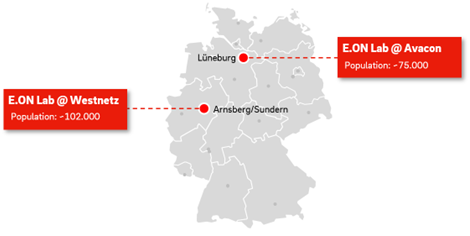
The two regions where our vision of a smart grid is being realized
Website and links to more information
E.ON – Ihr zuverlässiger Energiepartner | EON
Arnsberg und Sundern: Pioniere der smarten Energiezukunft (westenergie.de)
Smart Energy Region (avacon.de)
Social Media: